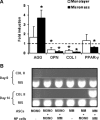Adipose stem cells for intervertebral disc regeneration: current status and concepts for the future
- PMID: 18298653
- PMCID: PMC4514100
- DOI: 10.1111/j.1582-4934.2008.00291.x
Adipose stem cells for intervertebral disc regeneration: current status and concepts for the future
Abstract
New regenerative treatment strategies are being developed for intervertebral disc degeneration of which the implantation of various cell types is promising. All cell types used so far require in vitro expansion prior to clinical use, as these cells are only limited available. Adipose-tissue is an abundant, expendable and easily accessible source of mesenchymal stem cells. The use of these cells therefore eliminates the need for in vitro expansion and subsequently one-step regenerative treatment strategies can be developed. Our group envisioned, described and evaluated such a one-step procedure for spinal fusion in the goat model. In this review, we summarize the current status of cell-based treatments for intervertebral disc degeneration and identify the additional research needed before adipose-derived mesenchymal stem cells can be evaluated in a one-step procedure for regenerative treatment of the intervertebral disc. We address the selection of stem cells from the stromal vascular fraction, the specific triggers needed for cell differentiation and potential suitable scaffolds. Although many factors need to be studied in more detail, potential application of a one-step procedure for intervertebral disc regeneration seems realistic.
Figures



References
-
- Dreinhofer KE. The Bone and Joint Decade 2000–2010 – How Far Have We Come? European musculoskeletal review. 2006;(Sept):12–7.
-
- Cowan CM, Aalami OO, Shi YY, Chou YF, Mari C, Thomas R, Quarto N, Nacamuli RP, Contag CH, Wu B, Longaker MT. Bone morphogenetic protein 2 and retinoic acid accelerate in vivo bone formation, osteo-clast recruitment, and bone turnover. Tissue Eng. 2005;11:645–58. - PubMed
-
- Evans CH, Rosier RN. Molecular biology in orthopaedics: the advent of molecular orthopaedics. J Bone Joint Surg Am. 2005;87:2550–64. - PubMed
-
- Bao QB, McCullen GM, Higham PA, Dumbleton JH, Yuan HA. The artificial disc: theory, design and materials. Biomaterials. 1996;17:1157–67. - PubMed
-
- Frick SL, Hanley EN, Jr, Meyer RA, Jr, Ramp WK, Chapman TM. Lumbar inter-vertebral disc transfer. A canine study. Spine. 1994;19:1826–34. - PubMed
Publication types
MeSH terms
LinkOut - more resources
Full Text Sources
Other Literature Sources
Medical

